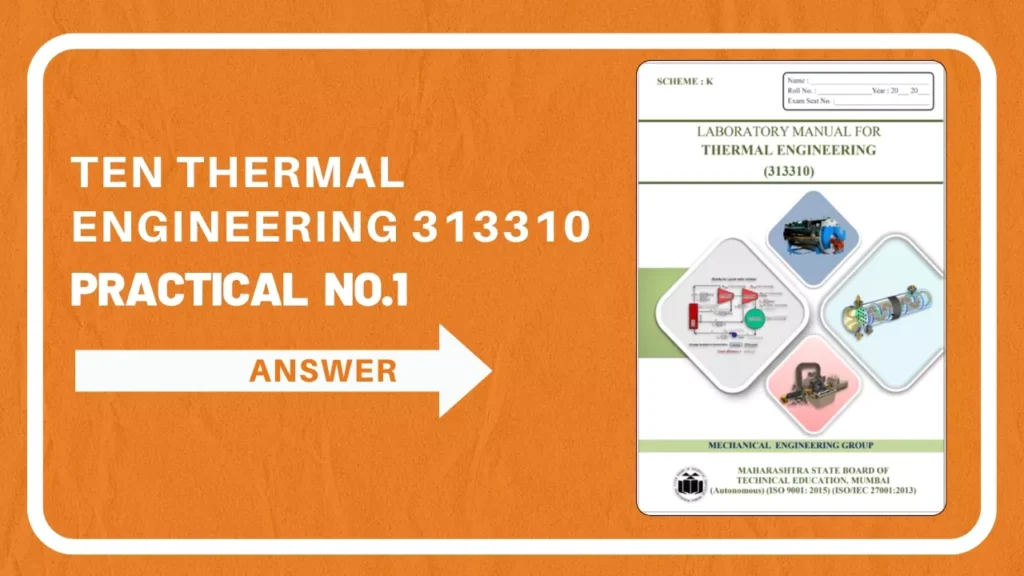TEN Thermal Engineering 313310 Manual Answer: Welcome to Practicalkida, in this blog post we provided TEN 313310 practical no.1 answer.

In various practicals of thermal engineering students need to measure the thermodynamic
properties or parameters like temperature, pressure, discharge, and energy consumption. To
perform these practicals students should be able to handle and read the instruments like
thermometers, pressure gauges, U-tube manometers, flow meters, energy meters,s, etc. Conversion of reading taken by these instruments in different units into SI units is also necessary.
TEN 313310 Manual Practical No.1 Answer
Practical No:1 Use a thermometer, pressure gauge, rotameter, and energy meter to measure temperature, pressure, discharge, and energy.
Required Resources /Apparatus/Equipment with specification
| S. No. | Parameters | Suggested Broad Specification | Quantity |
| 1 | Thermometers | 0-1100 C | 02 |
| 2 | Pressure gauges | 0-10 (Kg/cm2) / bar or 0-200 PSI | 02 |
| 3 | Energy meter | Single-phase energy meter | 02 |
| 4 | Reciprocating Air Compressor Test Rig | Working model of reciprocating air compressor showing bourdon pressure gauge (Range 0-12 Kg/cm2)/bar) at various locations. | 01 |
| 5 | Vapor Compression Refrigeration System test rig | Working model of vapor compression refrigeration system showing bourdon pressure gauge (Range 0-12 Kg/em2)/bar) on the high- pressure and low-pressure side and a water calorimeter to measure the temperature of water. | 01 |
Procedure
- Explain the working principle of a thermometer, bourdon pressure gauge, energy meter, etc.
- Explain the functions of each component of a thermometer, bourdon pressure gauge
energy meter, etc. - Explain the various scales marked on a thermometer, bourdon pressure gauge, and energy
meter, etc. - Select any one experimental setup as mentioned in the above table in which all parameters
like temperature, pressure, and electrical energy consumption can be measured. - Take readings with a thermometer, and bourdon tube pressure gauge mounted at various
locations on set up. - For the energy meter take a reading on the energy meter provided on the reciprocating air compressor test rig for compressor input or compressor/ heater input in the VCR test.
- Set the last decimal reading (red digits) of the energy meter at any convenient round digit.
- Start the air compressor, heater/ compressor in the VCR test rig
- Run the air compressor, and heater/ VCR compressor till the reading in the last (red decimal) changes to the next round digit.
- Record the difference in kWh (fractional) and the total time required in seconds in the given
observation table. - Write the readings in the observation tables provided for various instruments/equipment.
Observations and calculations
Observations –
Temperature measurement
Pressure measurement
Energy measurement
Calculations –
Temperature Measurement:

Pressure Measurement

Energy measurement
Results
We completed Practical No:1 and Used a thermometer, pressure gauge, rotameter, and energy meter to measure temperature, pressure, discharge, and energy.
Practical Related Questions
- List the different types of temperature-measuring instruments used in industries.
Answer:
- Collect specifications of different temperature measuring devices used in different applications.
Answer:
- Collect specifications of the bourdon pressure gauge used in different applications.
Answer:
- Explain the construction and working of the Bourdon pressure gauge with a neat sketch.
Answer:
Refer TEN Thermal Engineering 313310 Manual or textbook for this diagram.
- List the different applications where bourdon pressure gauges are used.
Answer:

- List the different types of pressure-measuring instruments used in industries.
Answer:



Thermal engineering manual answar
Thermal menual Answar
313310
Full answer
Nice
Manual answer full practice